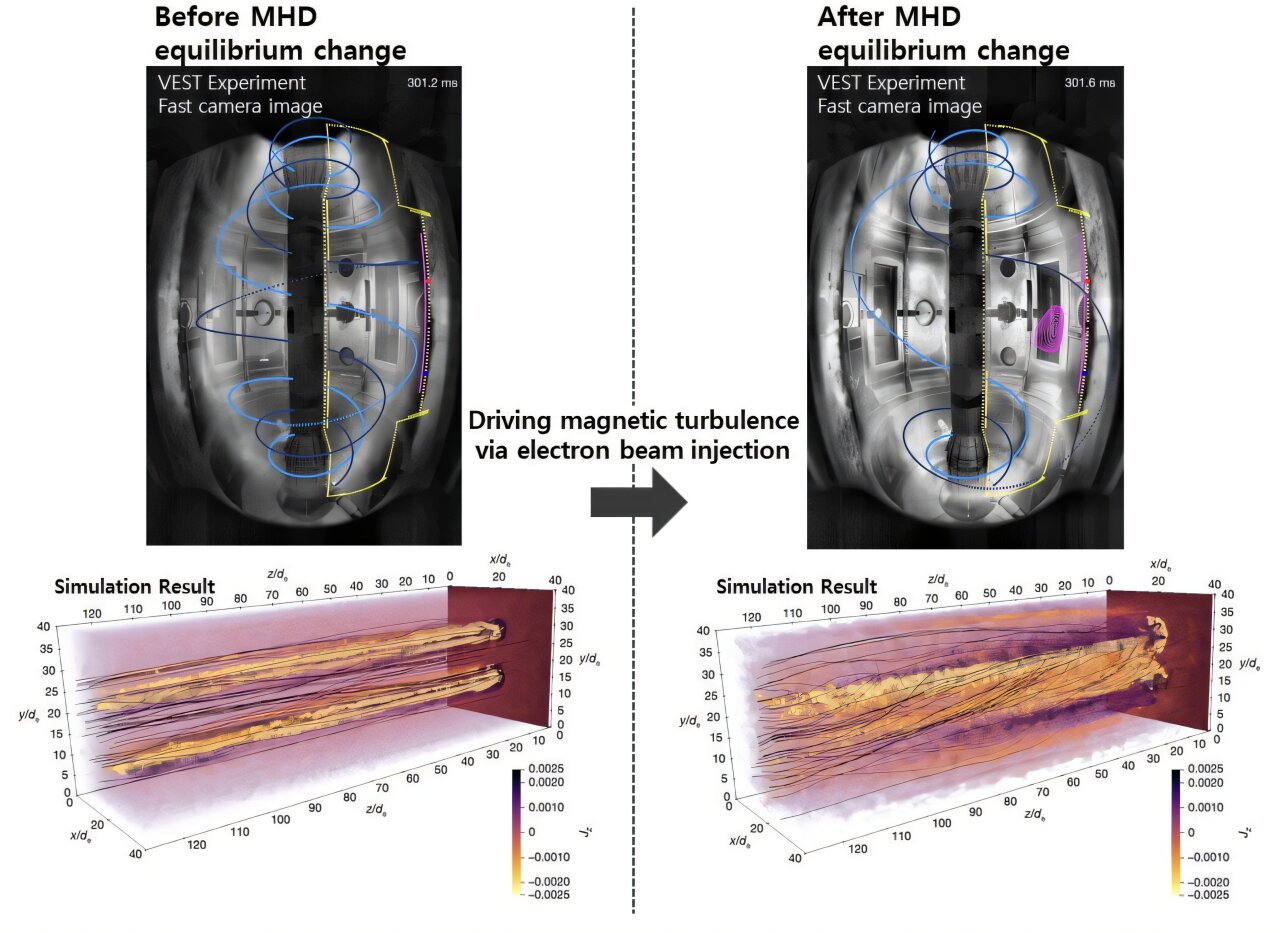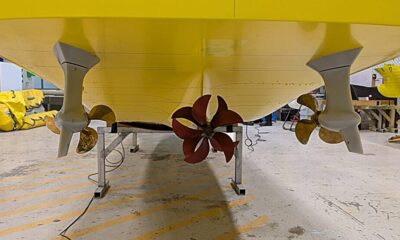Tech
First experimental proof of multiscale coupling in plasma has implications for fusion energy

Microscopic turbulence in plasma can trigger macroscopic structural changes. In complex physical systems, such cross-scale interactions—between different spatial and temporal scales—are known as multiscale coupling. To the best of their knowledge, Prof. Yong-Seok Hwang’s team, together with the Asia Pacific Center for Theoretical Physics, has now experimentally proven this phenomenon for the first time.
The work is published in the journal Nature.
The breakthrough resolves a long-standing puzzle in plasma physics, with implications for both fusion energy development and the study of astrophysical plasmas.
Seoul National University College of Engineering announced that a joint research team led by Prof. Yong-Seok Hwang from the Department of Nuclear Engineering, in collaboration with the Asia Pacific Center for Theoretical Physics (APCTP), has experimentally demonstrated the phenomenon of multiscale coupling in plasma—a long-standing puzzle in plasma physics—through the integration of fusion experiments and astrophysical plasma theory.
Initiated under the proposal of Prof. Hwang, who holds appointments in the Department of Nuclear Engineering and the Department of Energy Systems Engineering, the study was conducted solely by three Korean researchers.
The team included Dr. Jong Yoon Park, BK Assistant Professor at SNU and first author of the paper, and Dr. Young Dae Yoon, theoretical physicist at APCTP and corresponding author. This achievement, accomplished entirely by domestic researchers, is recognized as a milestone that significantly elevates Korea’s standing in global plasma science and technology research.
For plasma physicists, plasma—often called the “fourth state of matter,” distinct from solids, liquids, and gases—presents the formidable challenge of explaining how microscopic instabilities can drive macroscopic structural changes. The problem of multiscale coupling has therefore remained one of the most fundamental and long-standing issues in the field.
Plasma, however, is not only the essential medium for nuclear fusion reactions but also the predominant state of matter in the universe. Accordingly, understanding multiscale coupling in plasma has long been considered critical for both advancing fusion energy technology and unraveling the origins of the universe.
The team of Dr. Park and Dr. Yoon analyzed experimental data obtained from SNU’s fusion device and verified their findings through particle simulations using the KAIROS supercomputer at the Korea Institute of Fusion Energy. Their results proved that when microscopic magnetic turbulence is triggered, magnetic reconnection occurs effectively, inducing macroscopic structural changes within plasma.
The joint research team demonstrated for the first time that microscopic magnetic turbulence, deliberately induced by a strong electron beam, can increase plasma resistivity, thereby driving magnetic reconnection and ultimately producing large-scale structural changes—a direct experimental realization and proof of multiscale dynamics in plasma.
The study is particularly significant as an interdisciplinary achievement, combining experimental operations of Seoul National University’s fusion device with theoretical simulations conducted at APCTP.
This achievement also reflects the sustained efforts of Seoul National University and APCTP to provide early-career researchers with opportunities at an international level and to foster interdisciplinary collaboration. It stands as a representative case of advancing the global competitiveness of domestic researchers and nurturing future leaders in science and technology.
Dr. Jong Yoon Park, BK Assistant Professor at SNU, noted, “This outcome was only possible through countless discussions and debates between experts in fusion and theoretical physics, who started from different interests but ultimately arrived at common ground.
It is particularly meaningful in that it offers new clues to understanding the onset of magnetic reconnection, a process that plays a key role in cosmic phenomena such as solar flares and geomagnetic storms.”
Dr. Young Dae Yoon of APCTP added, “We hope this research will not only expand the framework of interpretation in plasma physics but also serve as a foundation for the development of new fusion technologies.”
More information:
Jong Yoon Park et al, Kinetic turbulence drives MHD equilibrium change via 3D reconnection, Nature (2025). DOI: 10.1038/s41586-025-09345-9
Citation:
First experimental proof of multiscale coupling in plasma has implications for fusion energy (2025, September 21)
retrieved 21 September 2025
from https://techxplore.com/news/2025-09-experimental-proof-multiscale-coupling-plasma.html
This document is subject to copyright. Apart from any fair dealing for the purpose of private study or research, no
part may be reproduced without the written permission. The content is provided for information purposes only.
Tech
‘The Running Man’ Conjures a Dystopian Vision of America That’s Still Not as Bad as Reality

Thirty-eight years later, The Running Man is back on our screens, playing to a world that seems to have caught up with the original’s idiocy. This new one features a considerably less bulky, but no less watchable star in Glen Powell, playing runner Ben Richards. Fired from various jobs for insubordination, and tending to a sick toddler, he’s press-ganged into joining America’s favorite kill-or-be-killed game show, after a producer identifies him as “quantifiably the angriest man to ever audition.”
The show’s premise has been tweaked a bit, too. Instead of navigating a series of video-game-like levels for the length of a TV broadcast, Richards must now survive in the real world for 30 days, surveilled by hovering network TV camera droids, pursued by armed-to-the-teeth “hunters,” private police goons, and a general public who spot and film runners using a proprietary app on their smartphones. The longer he lasts, and the more pursuers he can kill, the more money he makes. He’s cheered (and booed) by a massive audience of brain-dead oafs called Running Fans, glued to their screens 24/7. Like Schwarzenegger’s Richard before him, Powell makes the transition from onscreen villain to beloved folk hero, mugging for the cameras as his antics drive the ratings.
If it sounds familiar, it’s because this new version of The Running Man, which is cowritten and directed by Edgar Wright (Hot Fuzz, Scott Pilgrim vs. the World), draws as much from the original film and Stephen King’s source novel as it does from present-day reality. A modern-day America overseen by a game show president, where ICE squads team up with Dr. Phil McGraw to turn deportation raids into reality television, would seem ripe for a Running Man remake. But that’s the problem. Satire relies on caricature. And the new version is barely exaggerative. Does the very idea of a lethal game show seem that far off, in a world where the success of Netflix’s South Korean thriller series Squid Game (itself a variation on the The Running Man format) spawned an actual, licensed Squid Game-style competitive reality TV show? Or when a grinning zillennial YouTuber named “MrBeast” baits contestants with ten grand to sit in a bathtub full of snakes? A few weeks ago I watched live as rookie New York Giants’ running back Cam Skattebo’s ankle twisted 45-degrees, as if cranked by some invisible wrench, while a bar-full of rival fans cheered.
Tech
Why companies don’t share AV crash data, and how they could

Autonomous vehicles (AVs) have been tested as taxis for decades in San Francisco, Pittsburgh and around the world, and trucking companies have enormous incentives to adopt them.
But AV companies rarely share the crash- and safety-related data that is crucial to improving the safety of their vehicles—mostly because they have little incentive to do so.
Is AV safety data an auto company’s intellectual asset or a public good? It can be both—with a little tweaking, according to a team of Cornell researchers.
A new data-sharing roadmap
The team has created a roadmap outlining the barriers and opportunities to encourage AV companies to share the data to make AVs safer, from untangling public versus private data knowledge, to regulations to creating incentive programs.
“The core of AV market competition involves who has that crash data, because once you have that data, it’s much easier for you to train your AI to not make that error. The hope is to first make this data transparent and then use it for the public good, and not just profit,” said Hauke Sandhaus, M.S. ’24, a doctoral candidate at Cornell Tech and co-author of “My Precious Crash Data,” presented Oct. 16 at the ACM on Human-Computer Interaction.
His co-authors are Qian Yang, assistant professor at the Cornell Ann S. Bowers College of Computing and Information Science; Wendy Ju, associate professor of information science and design tech at Cornell Tech, the Cornell Ann S. Bowers College of Computing and Information Science and the Jacobs Technion-Cornell Institute; and Angel Hsing-Chi Hwang, a former postdoctoral associate at Cornell and now assistant professor of communication at the University of Southern California, Annenberg.
Barriers to sharing AV safety data
The team interviewed 12 AV company employees who work on safety in AV design and deployment, to understand how they currently manage and share safety data, the data sharing challenges and concerns they face, and their ideal data-sharing practices.
The interviews revealed the AV companies have a surprising diversity of approaches, Sandhaus said. “Everyone really has some niche, homegrown data set, and there’s really not a lot of shared knowledge between these companies,” he said. “I expected they would be much more commonality.”
The research team discovered two key barriers to sharing data—both underscoring a lack of incentives. First, crash and safety data includes information about the machine-learning models and infrastructure that the company uses to improve safety.
“Data sharing, even within a company, is political and fraught,” the team wrote in the paper. Second, the interviewees believed AV safety knowledge is private and brings their company a competitive edge.
“This perspective leads them to view safety knowledge embedded in data as a contested space rather than public knowledge for social good,” the team wrote.
And U.S. and European regulations are not helping. They require only information such as the month when the crash occurred, the manufacturer and whether there were injuries. That doesn’t capture the underlying unexpected factors that often cause accidents, such as a person suddenly running onto the street, drivers violating traffic rules, extreme weather conditions or lost cargo blocking the road.
Potential solutions for safer autonomous vehicles
To encourage more data-sharing, it’s crucial to untangle safety knowledge from proprietary data, the researchers said. For example, AV companies could share information about the accident, but not raw video footage that would reveal the company’s technical infrastructure.
Companies could also come up with “exam questions” that AVs would have to pass in order to take the road. “If you have pedestrians coming from one side and vehicles from the other side, then you can use that as a test case that other AVs also have to pass,” Sandhaus said.
Academic institutions could act as data intermediaries with which AV companies could leverage strategic collaborations. Independent research institutions and other civic organizations have set precedents working with industry partners’ public knowledge. “There are arrangements, collaboration, patterns for higher ed to contribute to this without necessarily making the entire data set public,” Qian said.
The team also proposes standardizing AV safety assessment via more effective government regulations. For example, a federal policymaking agency could create a virtual city as a testing ground, with busy traffic intersections and pedestrian-heavy roads that every AV algorithm would have to be able to navigate, she said.
Federal regulators could encourage car companies to contribute scenarios to the testing environment. “The AV companies might say, ‘I want to put my test cases there, because my car probably has passed those tests.’ That can be a mechanism for encouraging safer vehicle development,” Yang said. “Proposing policy changes always feels a little bit distant, but I do think there are near-future policy solutions in this space.”
More information:
Hauke Sandhaus et al, My Precious Crash Data: Barriers and Opportunities in Encouraging Autonomous Driving Companies to Share Safety-Critical Data, Proceedings of the ACM on Human-Computer Interaction (2025). DOI: 10.1145/3757493
Citation:
Why companies don’t share AV crash data, and how they could (2025, November 11)
retrieved 11 November 2025
from https://techxplore.com/news/2025-11-companies-dont-av.html
This document is subject to copyright. Apart from any fair dealing for the purpose of private study or research, no
part may be reproduced without the written permission. The content is provided for information purposes only.
Tech
This DOGE Whistleblower Is Running for Office

Chuck Borges has had quite the year.
In January, Borges started a new job as the Social Security Administration’s chief data officer, overseeing some of the most sensitive data systems in the federal government—including databases containing Social Security numbers, addresses, citizenship status, and benefits records of nearly every American.
Or at least that was the job description. Instead, he spent seven months struggling to get basic visibility into the systems he was statutorily responsible for, at times learning about how Elon Musk’s so-called Department of Government Efficiency (DOGE) was operating at the agency in press reports rather than internal discussions. By this summer, he filed a whistleblower complaint alleging that DOGE had copied and moved sensitive American data to an unsecure cloud environment. Borges was quickly forced to resign.
Now, Borges is launching his campaign for Maryland state senator.
In his first interview since the campaign began on Tuesday, Borges describes his clashes with DOGE, being sidelined at his own agency, and why he thinks technologists are needed to help steer this new era of government.
This interview has been edited for length and clarity.
WIRED: Why did you decide to run for office? And how did working under DOGE influence your decision to run?
Chuck Borges: I left SSA in late August, and the next month was very trying, both personally and professionally. There was a lot of congressional interaction. There was some media outreach. We had a lot of documentation to work on. I started to express to various local groups that they should be concerned about data privacy. This is not a partisan issue. It’s a nonpartisan issue that your data privacy should be concerning to you and that there’s risk involved.
In early October, the local Democratic Party reached out to me and asked if I would be interested in running for office. The reason I’m running is pretty simple—I worked at the highest levels of federal government and through that process I saw a lot of interactions with Congress. There’s a lot of concerns in the country today around government dysfunction and a lot of things just aren’t working.
DOGE didn’t influence my decision, but the dysfunction I experienced this year in general continued to motivate me to find ways to serve the public better.
When you first heard about DOGE involving itself at SSA, what did you expect would happen?
-

 Fashion1 week ago
Fashion1 week agoCoach reconnects with Bank & Vogue for upcycled bags using corduroy
-

 Tech1 week ago
Tech1 week agoCISOs in court: Balancing cyber resilience and legal accountability | Computer Weekly
-

 Sports1 week ago
Sports1 week agoNFL broadcaster Cris Collinsworth makes government shutdown joke as Seahawks clobber Commanders
-

 Politics1 week ago
Politics1 week agoAfghanistan rocked by 6.3-magnitude quake in Hindu Kush mountains
-

 Sports1 week ago
Sports1 week agoBears’ Colston Loveland bounces off 2 defenders to score clutch TD for win over Bengals
-

 Fashion1 week ago
Fashion1 week agoGermany’s Adidas achieves highest-ever quarterly sales in Q3 2025
-

 Business1 week ago
Business1 week agoFirst new Amazon electric heavy goods vehicles hit UK roads
-

 Business1 week ago
Business1 week agoHow To Claim Investments Of Deceased Holders: A Step-By-Step Guide For Mutual Funds & Bank Accounts


















